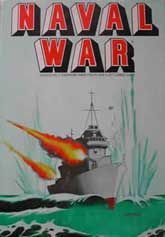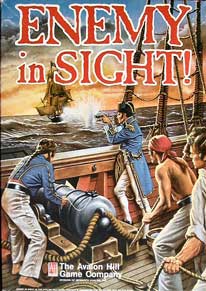|

|
Naval War and Enemy in Sight are card games from Avalon Hill “loosely based” on naval combat in the Napoleonic period and Second World War, respectively. Naval War is the older of the two (copyright 1983) while Enemy in Sight only appeared last year, but is very much a development of the original system.
 Dreadnought! Dreadnought!
Naval War is two card decks, a die and a 12 ¬page rule book (the rules take up just 7 pages) in a small box. The smaller deck of cards is the ships, each of which has a strength (between 3 and 9) and a gun calibre (12”, 14” etc.), plus its name, nationality and silhouette (the last three having no bearing on the game!). The larger deck is mainly comprised of Salvo cards, marked with gun calibres and the damage inflicted (between 1 and 4 points). A player’s turn consists of drawing a card from the pack and then playing (or discarding) one. If you have a ship with guns of the matching calibre, you can fire a salvo by placing the card on an enemy ship. Once accumulated salvo cards equal or exceed the ship’s strength, it sinks. Whoever played the last salvo adds the ship to his “sunk” pile. This continues until only one player is left or the deck is exhausted, when each player gains points equal to the ship’s strength for each ship in his “sunk” pile (losing 10 points if all his/her ships were sunk and gaining 10 if the last player left) and then a new round starts. First person to score 100 (or any other limit agreed before the start) wins.
This is the basic system, however the game is a little more complex. Some ships are aircraft carriers and don’t have a gun calibre. If you have one or more aircraft carriers, you can elect not to draw and play a card as normal, but instead make air strike(s) – one for each aircraft carrier. For each air strike you pick a target and roll the die; on a 1 the target ship sinks. Aircraft carriers can’t be attacked by salvoes until all the screening warships have been sunk. Using airstrikes can be a useful tactic, especially if you have more than one of them or want to prolong the hand (by making sure the pack takes longer to run out). In addition to salvoes, the playing deck has a number of other cards, each of which produces a different effect. These include Smoke screens (your fleet can’t be attacked until it is removed in your next turn) and repairs (allowing you to remove any one salvo that’s been played on you).
Some of the non-Salvo cards are red. These have to be played immediately (which can wreak havoc with your tactics!) and provide either an additional ship (taken from the first card deck and added to your fleet), a Minefield (played on someone else, it gives ALL his ships one or two points of damage) or submarines/ torpedo boats (attack one enemy ship – like an air strike, except that the torpedo boat sinks the target on a 6 and the sub on a 5 or 6).
Naval War is a classic ‘beer and pretzels’ game:- enjoyable, fairly simple and fast to play. There are decisions to be made on who to attack and how much you can afford to damage a ship without letting someone else sink it (and thus get the points), but like all card games there is a heavy luck element. This is moderated by playing the game in rounds, as someone who’s done well in one round gets hammered in the next.
 The Age of Sail The Age of Sail
Enemy in Sight applies the same basic card game to Napoleonic (or thereabouts) naval warfare. It comes in a standard-sized ‘bookcase’ box with 2 packs of cards, a die, rules and a sheet of markers. In this version of the game system, ships and salvoes (broad¬sides) are classified by ‘rate’ (1st to 6th) rather than gun calibre, and damage can be to rigging or hull (a ship sinks if its hull strength is exceeded and is dismasted if its rigging strength is gone). As in Naval War, players draw and play a card each turn and fire their broadsides in the same way as salvoes, choosing whether to affect the rigging or hull of the target. As you would expect, there are a number of differences from Naval War. Some changes have been made to the basic system, for example: broadsides may be fired by any ship with the appropriate rate or above (i.e. a 1st rate ship can fire any salvo, while a 5th rate can only fire 5th and 6th rate salvoes); the number of cards a player may hold in his hand is given by the number of ships he has in his line.
More important are the changes which are intended to reflect the conditions of Napoleon¬ic(-ish) sea battles. The first of these is a new card in the pack: The Boarding Party. Playing a Boarding Party on a dismasted enemy ship gives you a chance to capture it (roll a die: on a 5 or 6 you get it, on a 1 your ship is captured instead!). The odds can be modified by either or both sides playing an extra broadside as grapeshot (the difference in damage inflicted modifies the die roll required). Once captured, a ship may be added to a player’s line or taken as a prize and held behind the line. Like sunk ships, prizes are worth points at the end of the game, but any damage is deducted from the points scored. However, if a prize can be returned to port (a marker for each player designates what’s in port) it is worth double points immediately and can then return to sea and join the player’s line. This is accomplished with a ‘Refuse Battle’ card, Enemy in Sight’s equivalent of the ‘Smokescreen’ in Naval War. This card makes a player’s ships immune to attack for one round. It also allows him to take ships back to port (dismasted ships can be towed) or bring ships out of port. As ships returned to port have all damage removed immediately, there are obvious advantages to doing this. However, you must remember that you need another ‘Refuse Battle’ to get the ships back out and the random sequence of the cards means you may never get one. There are also cards which affect ships in port: ‘Blockade’ makes it more difficult to get ships out of port; and a ‘Fire ship’ will attack ALL ships in port, rather than just one at sea. The effect is that you need to weigh up the pros and cons of using a ‘Refuse Battle’ carefully.
The other major change is the ‘Break the Line’ cards. As with Naval War’s ‘Minefield’, these inflict damage on all a player’s ships. In addition, each ‘Break the Line’ card is marked with a nationality. Ships of that nationality (regardless of which player owns them) may then attack prizes behind the broken line. The attacking player also designates from 1 to 3 of his ships as ‘Line-breakers’; these can only attack the broken line. If all the ‘Line-breakers’ are sunk or dismasted the ‘Break the Line’ card is removed. As with Naval War, this card has a powerful effect on the player it is played on. However, unlike Naval War, it also has an effect on the player who plays it: his ‘Line-breakers’ can only attack the broken line and that line is likely to concentrate on removing his ‘Line¬breakers’ in order to get rid of the card. Again, the use of the card needs to be carefully considered.
Like Naval War, Enemy in Sight has its complement of red cards which must be played as soon as they are drawn. The play is slightly different in that most of these cards have some condition attached to them and are passed from player to player until reaching one who has ship(s) which meet the condition or returning to the player who drew the card. As passing the card on counts as a player’s turn, the turn can move round the board very quickly! Most of the cards involve the loss of a ship for some reason or other (‘Admiralty’s Orders’, ‘Run Aground’), but the nastiest is ‘Fire’. Once started, a fire burns, increasing the damage inflicted by 1 each turn (for the affected player), until the ship sinks (if the fire starts in the rigging, it burns that first and then starts on the hull!). A nasty, lingering death for a ship! Fires can be put out by playing a ‘Bucket Brigade’, but any damage remains (it can be removed by returning a ship to port). Effectively ‘Fire’ means the loss of a ship as well, it just takes longer.
Final Salvo
The object of all these additions and changes to Enemy in Sight compared with Naval War is to convey more of the flavour of 19th century naval warfare. They are certainly not intended to make the game a serious simulation of the subject – as the introduction to the rules makes clear. Which begs the question “Why bother?” If the game isn’t intended to be a simulation, then it doesn’t need to convey much of the feel of the real thing – as with Naval War. The complications built in to Enemy in Sight (which are indicated by the provision of markers as well as cards and the need to write more explanation on the cards) mean that more consideration of tactics is required. This makes the game more difficult to learn and slower to play than Naval War and moves it out of the ‘beer and pretzels’ class of simple, fast games. This is not to say that it is a bad game (in fact the increased tactical options make it a more skilful game than Naval War, in which the luck of the cards is crucial). I consider Enemy in Sight quite a decent game and I will certainly be playing it again. However, I find that the added complication detracts more from the flow of the game than it adds to my enjoyment of it. If I want a game to play in the pub or to fill an hour at a convention, I shall reach for Naval War in preference to Enemy in Sight.
This review was originally published in issue 34 of The Small Furry Creatures Press (later Games Games Games magazine) in August 1989.
/
|
 Dreadnought!
Dreadnought! The Age of Sail
The Age of Sail